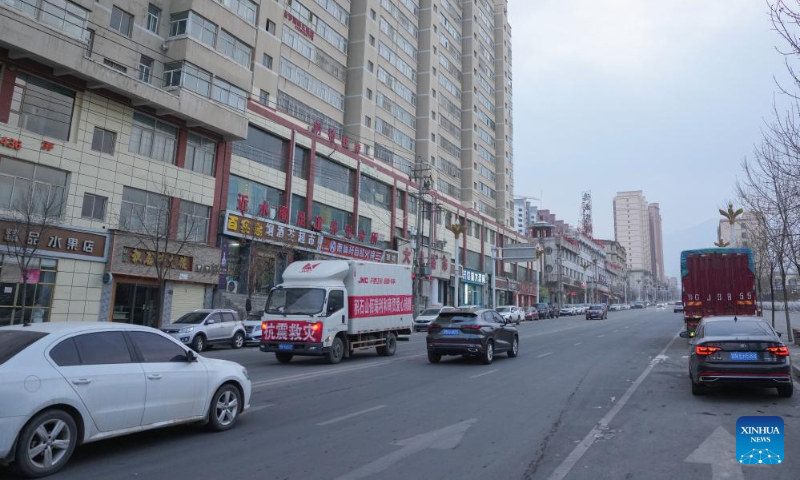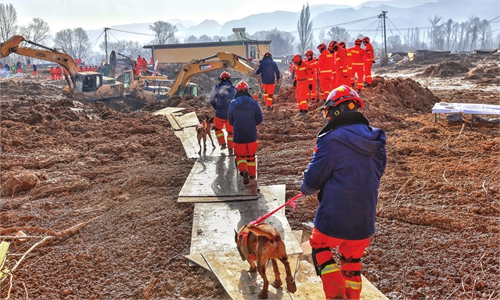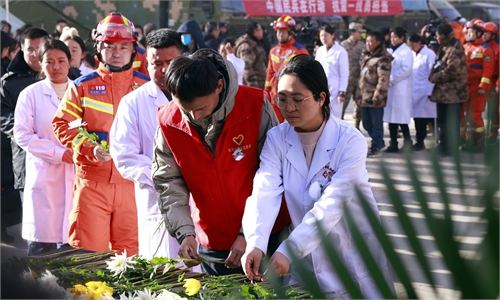Recent earthquake disaster highlights the urgency of improving the seismic performance of rural houses: experts

This photo shows a main road in Jishishan County, northwest China's Gansu Province, Dec. 23, 2023. After a 6.2-magnitude earthquake hit Gansu Province late Monday, all-out rescue and relief work has been underway to restore the daily life and production of local people. The supply of daily necessities has resumed gradually and the local market has regained its order. (Xinhua/Chen Bin)
Regarding the causes behind a recent earthquake disaster which struck Northwest China's Gansu and Qinghai provinces, experts explained on Sunday that the main reasons for the collapse of houses in the earthquake-affected areas is because the epicenter of this earthquake was very shallow and rural houses were mainly self-built, and their seismic performance varies.On December 18 at 23:59, a 6.2-magnitude earthquake with a depth of 10 kilometers struck Jishishan county, Northwest China's Gansu Province. As of 8 am on December 22, it has caused a total of 117 deaths, 781 injuries, and nearly 15,000 houses collapsed in the local area. After the earthquake, the Gansu Provincial Department of Housing and Urban-Rural Development organized response teams to conduct emergency assessments of the affected houses.
Wang Yong, deputy director of the Gansu Provincial Department of Housing and Urban-Rural Development, explained that the epicenter of this earthquake was very shallow and it was a "thrust" earthquake, which released more energy. At the same time, Jishishan county is located on a sedimentary stratum, in the transitional area between the Loess Plateau and the Qinghai-Xizang Plateau, on the western edge of the Loess Plateau. Studies have shown that earthquakes in the Loess Plateau region often have significant site amplification effects, causing greater surface damage.
According to the intensity map of the Jishishan 6.2-magnitude earthquake released by the Ministry of Emergency Management, the maximum intensity of this earthquake reached level VIII, with an area of level VIII reaching 331 square kilometers, mainly affecting areas such as Dahejia town, Liuji township, Shiyuan town, and Liugou township in Jishishan county.
Wang said that this maximum intensity exceeded the 7-degree design intensity for seismic fortification determined in the relevant annexes under national standards. At the same time, rural houses are mainly self-built, and their seismic performance varies. These are the main reasons for the collapse of houses.
Ma Yandong, director of the Village and Town Construction Division of the Gansu Provincial Department of Housing and Urban-Rural Development, noted that from the assessment situation, most of the collapsed and severely damaged rural houses in this earthquake were older dwellings, mainly consisting of auxiliary houses and houses built by villagers. These houses are mostly mud or brick-wood structures. The connections between the walls and the wooden frames are not well reinforced, and the overall integrity is weak, resulting in poor resistance to high-intensity earthquakes.
"In recent years, Jishishan county has been promoting the renovation of rural dilapidated houses to solve the safety issues of the main residential houses for the local people, and providing subsidies to those that pass the inspection." Ma said that these newly built or renovated rural houses have basically not experienced overall collapse, and the main problems are wall cracks and external flashing.
In addition, although some communities have built new houses, some villagers still prefer to live in old houses with a heated brick bed used during the winter. Compared to new houses with heating stoves, heated brick beds in old houses are more convenient and economical for heating. A government evaluation has found that many casualties were the result of residents trapped in older dwellings.
Experts have pointed out that the recent earthquake disaster highlights the urgency to improve the seismic performance of rural housing. Enhancing the seismic performance of rural housing requires efforts from multiple parties. It is necessary to further promote and enhance the awareness of earthquake resistance in rural house construction, strengthen technical guidance and construction management for earthquake resistance in rural houses, promote the use of building materials with better seismic performance, and train qualified rural construction builders.
Experts also suggest increasing support for seismic retrofitting of rural houses in remote areas to improve the quality and safety of rural housing, and continuously improving the seismic resistance of housing outside of major urban centers.
Global Times


